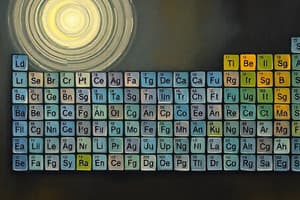Podcast
Questions and Answers
Which block of the periodic table do transition elements belong to?
Which block of the periodic table do transition elements belong to?
- s-block
- d-block (correct)
- f-block
- p-block
How many series of transition elements are there in the periodic table?
How many series of transition elements are there in the periodic table?
- 2 series
- 3 series
- 4 series (correct)
- 5 series
Which groups of the periodic table contain transition elements?
Which groups of the periodic table contain transition elements?
- Groups IIIB, IVB, VB, VIB, VIIB, VIII, IB, and IIB (correct)
- Groups IIIA and IVA
- Groups IA and IIA
- Groups VIIA and VIIIA
What is the general electronic configuration of transition metals?
What is the general electronic configuration of transition metals?
Where do transition elements lie in the periodic table?
Where do transition elements lie in the periodic table?
Which element in the first transition series has the highest melting point?
Which element in the first transition series has the highest melting point?
Which of the following is responsible for the variable oxidation states exhibited by transition metals?
Which of the following is responsible for the variable oxidation states exhibited by transition metals?
Which of the following statements about manganese is correct?
Which of the following statements about manganese is correct?
Which property of transition metals is responsible for their catalytic activity?
Which property of transition metals is responsible for their catalytic activity?
Which of the following statements about the magnetic properties of transition metals is correct?
Which of the following statements about the magnetic properties of transition metals is correct?
Which of the following properties of transition metals is related to the presence of unpaired d-electrons?
Which of the following properties of transition metals is related to the presence of unpaired d-electrons?
Flashcards are hidden until you start studying
Study Notes
Transition Elements Overview
- Transition elements belong to the d-block of the periodic table, where the last electron enters the d subshell.
- There are four series of transition elements in the periodic table: the first, second, and third transition series, along with the lanthanides and actinides (f-block).
Group Associations
- Transition elements are found in groups 3 to 12 of the periodic table.
Electronic Configuration
- The general electronic configuration for transition metals is (n-1)d¹⁰ns², where n represents the outermost shell.
Position in the Periodic Table
- Transition elements are located in the center of the periodic table, between the s-block and p-block elements.
Melting Points
- In the first transition series (scandium to zinc), chromium has the highest melting point.
Oxidation States
- Variable oxidation states in transition metals are primarily due to the presence of partially filled d-orbitals.
Statements About Manganese
- Manganese is well-known for its diverse oxidation states, including +2, +4, +6, and +7.
Catalytic Activity
- The catalytic activity of transition metals is attributed to their ability to form intermediate complexes, primarily due to unpaired d-electrons which facilitate electron transfer.
Magnetic Properties
- Most transition metals exhibit paramagnetism due to the presence of unpaired d-electrons; this leads to magnetic properties.
Unpaired d-Electrons
- Properties related to transition metals, such as color and magnetism, are influenced by the presence of unpaired d-electrons within their atomic structure.
Studying That Suits You
Use AI to generate personalized quizzes and flashcards to suit your learning preferences.




